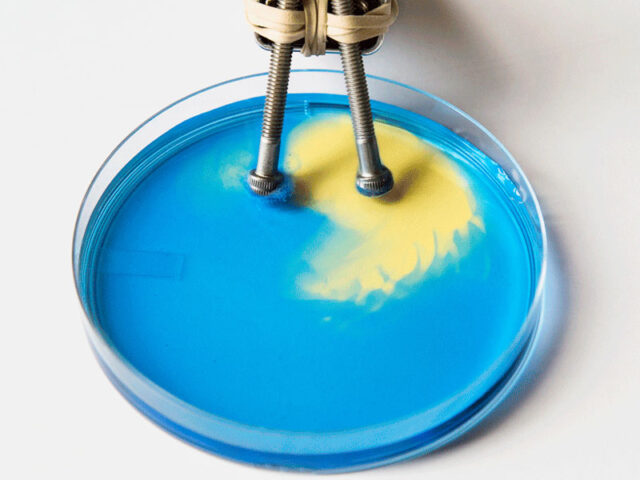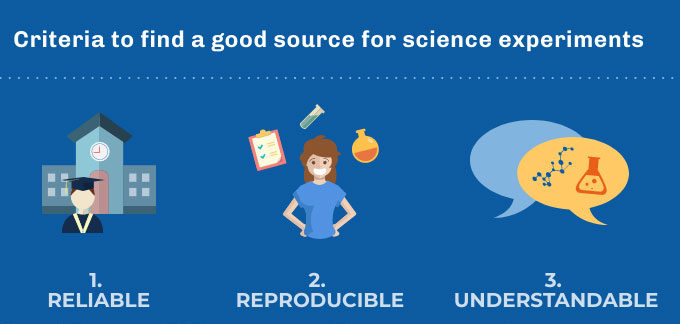The Internet is full of great science resources — if you only know where to look. Are you searching for experiments to do at home, in class, or simply to get people excited about DIY chemistry? You can spend hours on the Internet looking at tutorials, videos, or ideas on Pinterest. There are so many that it is easy to get lost! So here are some tips on how to efficiently navigate this sea of information.

Finding a good source
What is a good source for science experiments? My criteria are:
- A reliable one – I like to know who the authors are, if not by name, at least by their professional qualifications. The fact that the content is endorsed by an institution is also a good indicator. But in any case, I apply one basic scientific rule: always cross-check the information I find!
- A reproducible one – When I don’t want to spend hours in tests just to see if the experiment works, I select tutorials that include a detailed list of materials, step-by-step instructions and pictures. If possible, a video is even better, as it gives me a more realistic idea of the result I can expect.
- An understandable one – I appreciate it when the tutorial is accompanied by an explanation in plain English. A good explanation gives me another indication of the quality of the source, and even when I already know the science behind the experiment, it can give me good ideas on how to explain it to others.
Online DIY chemistry resources
Here are 3 great websites I like to visit when I need inspiration:
The Exploratorium
Opened in 1969 in San Francisco, it was the first hands-on science museum in the world. Its education portal offers hundreds of experiments and projects, developed by experienced teachers and scientists. Of all online resources, this is my personal favorite. The Exploratorium is the most innovative science center I know, and one of the very few places you will find a never-seen-before experiment. It covers all scientific subjects; for chemistry, I recommend trying two experiments on electrolysis, one producing colors and the other small explosions!
 The Royal Society of Chemistry
The Royal Society of Chemistry
If you are a scientist, you probably do not need a presentation of the RSC. But did you know that the UK’s professional body for chemists also has a dedicated education website? On it you will find more than a wealth of resources for teaching chemistry at secondary and higher education levels, including a series of very simple experiments that you can do at home. I particularly like their thematic collections, such as edible experiments or chemistry in sports series.
 Steve Spangler Science
Steve Spangler Science
Steve Spangler is a former science teacher, turned TV « science guy ». His company website features an impressive experiment library. Although in my experience some of them just won’t work, I really like the way that classic experiments are transformed into exciting, surprising and fun activities, perfect to catch the attention of the public! I have found great ideas on this website, such as an experiment on antiacids, or a safer version of the famous elephant toothpaste that children can do themselves.
Finding the materials
Most of DIY chemistry experiments do not require specialized lab equipment or reagents.
But if you do not have access to a lab and want to do experiments that use uncommon chemicals, you can usually order them from the pharmacy (you may have to explain why you want them!), or buy them from organic grocery stores or big supermarkets that have a sizable hardware aisle.
You will also find useful items, such as plastic pipettes, in those same big supermarkets, in the DIY or creative hobby aisle. And if you really want to buy specialized equipment, there are online stores that specialize in science supplies for the classroom.
Bridging the cultural gap!
Some of the best science experiment resources are from the US, which can be problematic if you live in Europe. Apart from the fact that you will need a calculator to convert everything into metric system units, some items that are very common in the US turn out to be difficult or sometimes impossible, to find!
Here are a few tips that should be useful:
- Karo syrup is a brand of glucose syrup; you can find glucose syrup in baking supply shops or in big supermarkets.
- Ivory soap is a bar of soap that has lower density than other soaps. If an experiment asks for this particular brand, it will not work with just any soap. You have two solutions: find a way to order Ivory soap online, or spend a little time experimenting yourself with different brands, to see if you can find one that has much lower density than others!
So, time to be creative! Can you think of an (easy) experiment to pick out the bar of soap that has the lowest density? Please share your ideas in the comments below!


Leave a comment
The editors reserve the right not to publish comments or to abridge them.